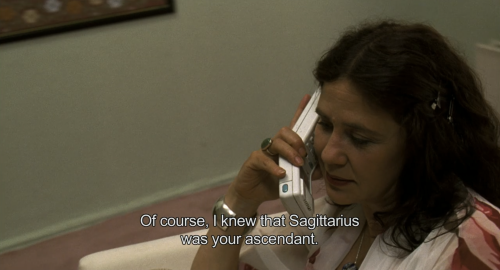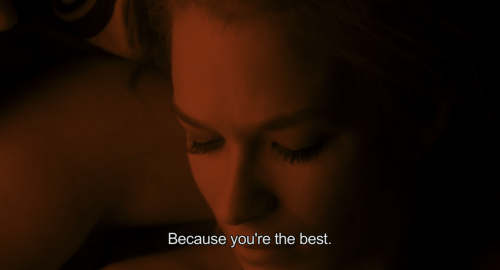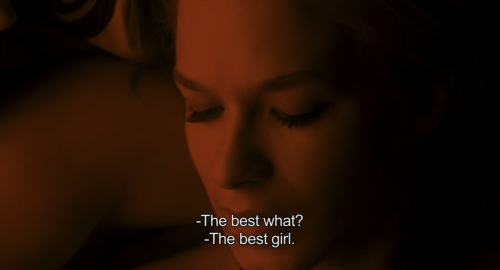#run lola run
“Should I grow old, waiting for a man who won’t stand by me?“
- Nina Petri as Jutta Hansen in Run Lola Run(1998)
Post link
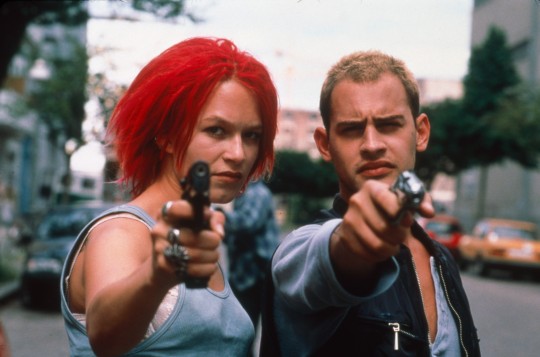
Half the fun of watching German director Tom Tykwer’s thriller RUN LOLA RUN (’98) is reveling in all of the visual details. There is so much to take in from Frank Griebe’s excellent cinematography to the brilliant use of color and objects that enhance the film’s themes. RUN LOLA RUN stars Franka Potente as Lola, a young woman who must secure 100,000 Deutschmarks and deliver the money to her boyfriend Manni (Moritz Bleibtreu), who desperately needs the cash to pay off a violent gangster. Lola has 20 minutes to complete her mission. The film explores three different outcomes as Lola encounters a variety of obstacles along the way.
Let’s first look at the film’s brilliant use of color. Red and yellow are strategically associated with the two lead characters. Lola is presented with the color red. Her hair is dyed bright red, and each of the three-time loops begins with her hanging up a red phone. Red continually appears at various points in her story, whether it’s a bicycle thief wearing a red shirt or her carrying a red bag full of cash. The image of Potente wearing a red wig and running through the streets of Berlin has become the visual symbol of RUN LOLA RUN and usually the first thing that people will remember about the film. Yellow is Manni’s color. He calls Lola from a yellow telephone booth as he contemplates robbing the grocery store across the street, which just happens to be adorned with yellow fixtures and trim.

Red can be seen to symbolize passion but is also represents speed, especially since Lola is moving at such a frantic pace. Yellow is the complete opposite. It symbolizes the tension-filled act of waiting. This can be observed in one particular scene in which workers dressed in yellow hazmat suits carry a large piece of glass from one side of the street to another. They are confronted with a red ambulance driving at a high speed to bring a cardiac patient to the hospital. This scene is played out in each of the three scenarios with a different result. In other scenes, Lola passes a yellow subway tram, a visual reminder that time is passing and Manni is waiting for her.
One of my favorite, and a bit more subtle, use of color in the film is when green is associated with some form of authority. When Lola visits her dad’s bank to ask for money, his office is adorned with green furniture and a large green painting that Lola rips off the wall in anger. In one scenario, policemen driving green and white vehicles and dressed in green uniforms confront Lola and Manni.
Because the film is so focused on time—not only how Lola is pressed for time but also how one small act can change one’s destiny—clocks and watches are important symbols that pop up throughout the film. There is a big ornate clock in Lola’s bedroom, the face of which is taped over with green stickers, which could be seen as a symbol of how time exerts its authority over her. Manni is constantly checking the clock that hangs above the grocery store entrance, Lola shatters the glass clock in her father’s office with her ear-piercing scream and an old lady checks her watch to give Lola the time. In the casino scene, Lola chooses to play the number 20 on the roulette wheel, which plays to the fact that she only has 20 minutes on the clock to finish the job.
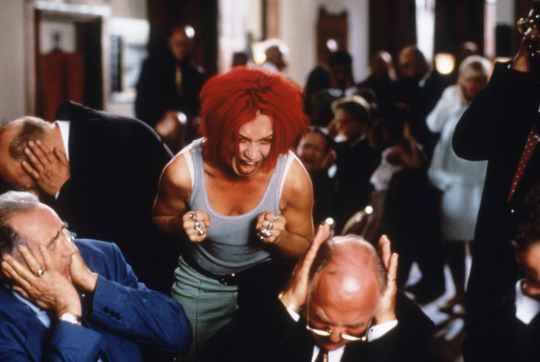
Tom Tykwer drew a lot of inspiration from Alfred Hitchcock’s classic thriller VERTIGO (’58). For the casino scene, Tykwer had production designer fill in empty space on the wall by creating a replica of the iconic Carlotta painting from Hitchcock’s film. VERTIGO also inspired the spiral motif that can be seen throughout the film. As Manni calls from the yellow phone booth, the viewer can spot a shop called Spirale in the background complete with a spiraling fixture. When Lola sets out on her mission, she runs down a spiral staircase, presented in the film through animation rather than live-action. As each of the time loops resets, we see Lola and Manni, contemplating life while resting on pillows with a spiral print.
Cinematographer Frank Griebe also employs the sensation of vertigo through many excellent camera shots. Arc shots, in which the camera circles a subject, are used throughout the film. There are lots of tight close-ups, tracking shots, low angle-shots and top-down perspectives, which beautifully demonstrate the heightened emotion and tension felt by the characters. The camera is constantly moving and so is the imagery. In addition to animation, there are black-and-white flashback scenes, stop motion sequences and when time stops for a moment, those scenes are presented with a hazy filter. The bounty of visual symbolism and the film’s frenetic pace make RUN LOLA RUN a highly enjoyable experimental thriller.
WISH / KOMM ZU MIR ( 1999 )
by::Franka Potente & Thomas D
for Run Lola Run
it’s an interesting fun idea of her conversation with god:
It starts out a soft wistful admittance of how she wishes things were, a little bit of a mourning over unfulfilled beauty. Just humble simple innocent mumbling dreams to herself.
But then it like grows and grows into something stranger in tone. [It’s in german so im just making shit up] but in my head he’s saying ‘Come to me’/’Come tell me’.
and makes his presence known, his power known. He’s not just there to listen to empty prayers, he tempts her with his ability to do something about her wishes.
She hears it and her face changes and demands change (but the interesting thing is they’re still innocent and romantic almost, just hungry for life and its possibilities and limits, similar to the movie.)
Like
‘I wish I was a stranger who wanders down the sky, I wish i was a princess with armies at her hand, I wish I was a ruler who’d make them understand’
awww
So it becomes really interesting in this rotating in a dark room camerawork of like a deal being made, a bargain of him explicitly asking her to reveal admitting what she wants out of life, what beauty she sees possible, and him gaining sort of this dynamic of being the mysterious maker of the world.
Then his verse starts and its just almost…disappointing and disheveled? disillusioning? incoherent unstable madness? even timid…?
it reminds me of movie ‘MindGame’ * where god changes into a million ridiculous shapes. (but actually that one is more like life is meaningless, whereas in this song its more like god is confused)
It’s like god himself is overwhelmed and confused with possibility. Insecure about what to do with his own power
So yeah after his verse, their dynamic changes; the entire religion of the whole song changes.
She repeats the first verse again with a different power and expression, a new kind of control knowing gods helplessness.
IDK i just like the disillusionment of the 21st century, i like simple hypothetical situations like this presented in weird ways, where we see collisions between a lot of ideas. (Also no this isn’t the real meaning of the song at all lmao, i cant German, so idk what its about)
*MindGame meeting god:



